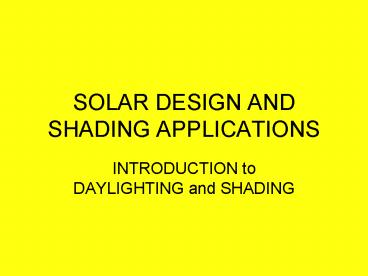SOLAR DESIGN AND SHADING APPLICATIONS - PowerPoint PPT Presentation
1 / 62
Title: SOLAR DESIGN AND SHADING APPLICATIONS
1
SOLAR DESIGN AND SHADING APPLICATIONS
- INTRODUCTION to DAYLIGHTING and SHADING
2
Getty Museum LA
3
Getty Museum LA
4
E. Faye Jones
5
Emilio Ambasz Acros Building Japan
6
Classroom N.C. Innovative Design
7
SOLAR PATH
8
(No Transcript)
9
SOLAR ALTITUDE
- Vertical angle of the sun's position above the
horizon (0 - 90 plus)
10
(No Transcript)
11
AZIMUTH
- Angle of sun east or west of south
12
(No Transcript)
13
ZENITH
- Sun position directly overhead (90)
14
(No Transcript)
15
(No Transcript)
16
(No Transcript)
17
(No Transcript)
18
SITE ANALYSIS VIEWSHED
19
SHADING STUDY
COURTYARD VIEWSHED Center
of Courtyard Master Bedroom
Office
The viewshed diagram shows the time of the year
any solar obstruction will occur, by looking at
the corresponding sun path. Here, the office
space shades the courtyard in the early morning
hours of the summer time, while the master
bedroom shades the courtyard in throughout the
afternoon in the winter and late afternoon in the
summer time.
20
DAYLIGTING RIGHT-TO-LIGHT STUDY
DAYLIGHT OBSTRUCTION
SHADING MASK
21
(No Transcript)
22
(No Transcript)
23
(No Transcript)
24
SUN RAY GEOMETRY winter solstice, noon
25
SUN RAY GEOMETRY equinox, noon
26
SUN RAY GEOMETRY summer solstice, noon
27
SITE ANALYSIS 3D TERRAIN MODELING
28
SUNPATH / SOLAR STRESS
East Elevation
South Elevation
29
SHADING STUDY SUNPATHS
30
SHADING STUDY SHADOW PATTERNS
31
Solar Control
- Effects of sun are more problematic in hot
climates than in cold ones - Design should reflect seasonal variations in
solar intensity
32
Solar Control
- For areas that can be too hot for comfort
- well considered window placement
- use overhangs to shade walls and openings
- use site features like foliage for shading
- incorporate covered porches
- Radiant barrier, insulation
- use light colored walls
- E/W orientation the best
- Intercept the heat outside the building
(defensive) - Exterior elements (awnings)more effective than
interior(blinds / curtains)
33
Solar Control
- For areas that can be too cold for comfort
- max southern exposure
- EW exposures are warmer in summer and colder in
winter than are S, SW and SE exposures - increase thermal mass and envelop insulation
- use darker surfaces
34
Passive Cooling
- Through Natural Ventilation
- Passive Cooling- remove warm air from building,
replace it with cooler air, without the use of
mechanical assistance - Other methods of passive cooling
- Control Radiation, Evaporation and
Dehumidification, Mass Effect ( thermal storage)
35
CLIMATE ANALYSIS WIND ROSES
36
SOLAR CONTROLShading
37
3 Types of Shading configurations
38
3 Types of Shading configurations With shading
pattern (mask)
39
(No Transcript)
40
(No Transcript)
41
(No Transcript)
42
(No Transcript)
43
(No Transcript)
44
(No Transcript)
45
(No Transcript)
46
(No Transcript)
47
(No Transcript)
48
(No Transcript)
49
(No Transcript)
50
(No Transcript)
51
(No Transcript)
52
Building -Self Shading
53
2 different shading methods Same shading mask
54
(No Transcript)
55
(No Transcript)
56
- Merge Sun Path with Shading Mask
- Provides time and location of shading
57
SHADING / SUNLIGHT ANALYSIS Palmer Residence
Alta, Wyoming 43.7 N -111.0 W
58
SOLAR STRESS
Living room
Sun incident to south-facing glazing from
mid-September to April.
59
SOLAR STRESS
Guest room
Sun incident to west-facing glazing throughout
the year in December from 2 pm to 5 pm, and in
June from 5 pm to 9 pm
60
SOLAR STRESS
North patio
Sun does not reach the glazing of the north
patio. Only diffuse light is admitted throughout
the year.
61
SOLAR STRESS
North bay windows
Sun incident to north-facing bay windows from
April to mid-September, in the early mornings and
late evenings. Most radiation likely obstructed
by surrounding topography due to low sun angles
at these times.
62
(No Transcript)































